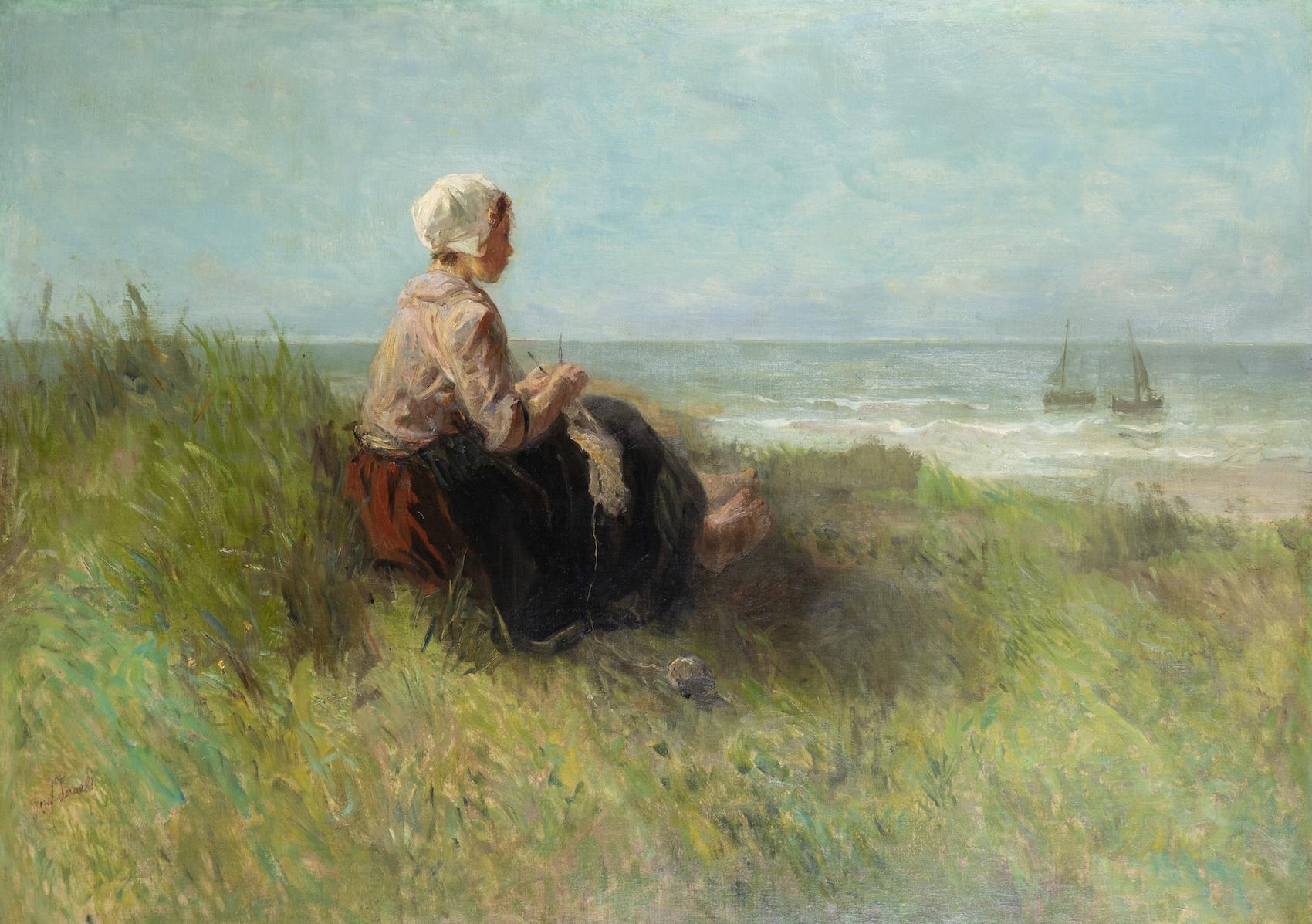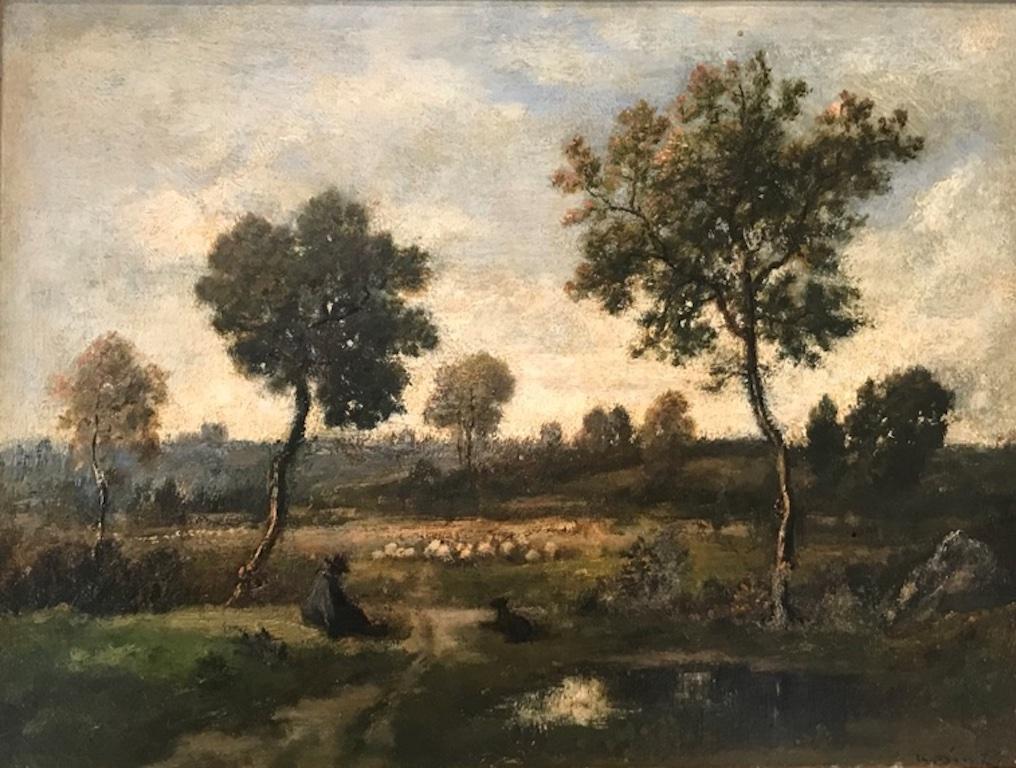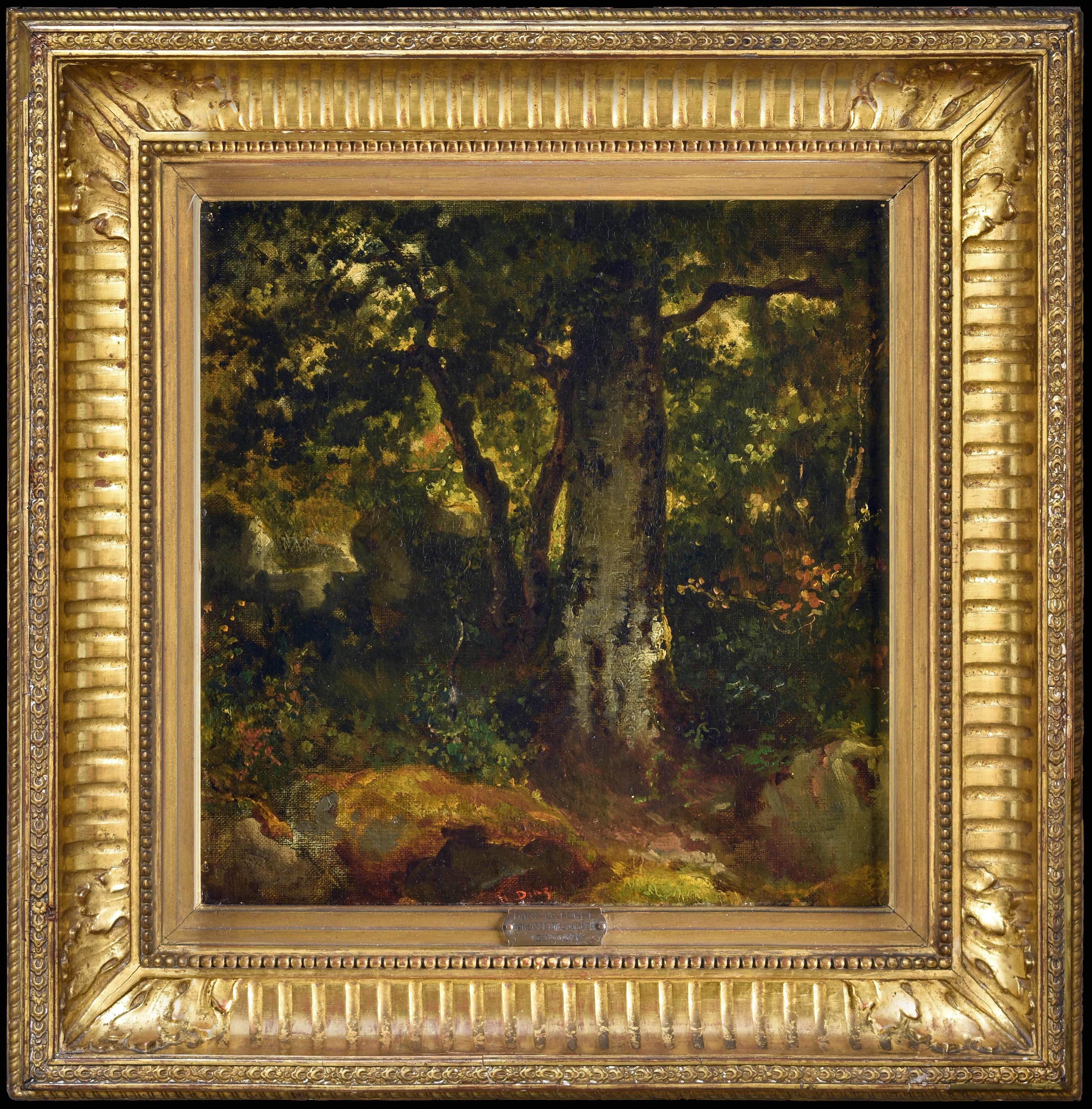Items Similar to Léon Adolphe Belly, Woodland View With Pond, Oil Painting
Want more images or videos?
Request additional images or videos from the seller
1 of 12
Léon Adolphe BellyLéon Adolphe Belly, Woodland View With Pond, Oil Paintingc. 1870
c. 1870
About the Item
This 19th-century oil painting by French artist Léon Adolphe Belly (1827-1877) depicts a woodland view with a pond and women washing clothes. It’s a gentle portrayal and a far stretch from his grander ‘orientalist’ paintings.
With relentless dedication, Belly undertook numerous exhausting missions to the expansive plains and claustrophobic heat of 19th-century North Africa where travel was debilitating, particularly for a dapper Frenchman, built for the playground of Paris. He did so in search of the ‘orient’, a theme in French Academic art made popular by painters such as Eugène Delacroix and Jean-Léon Gérôme. Belly’s orientalist works combine a rich tapestry of colour and exquisite details. Vast horizons under a crisp heat, fully-laden camels resting under boughs, women gathering water from a river. These were the masterpieces which sang to the hanging committee of the illustrious Paris Salon. They lapped it up and his career was secured.
Yet, when returning from his various travels, his work took on a different atmosphere. Away from the scorching banks of the Nile, he turned to the rich and varied topography of Fontainebleau, near Paris. These magical woods have inspired numerous artists over the years including painter Théodore Rousseau (1812-1867) who, along with several of his contemporaries, became the first to truly embrace painting entirely outdoors. Belly’s work at Fontainebleau is quieter and less flamboyant. It lacks the attention-seeking bravura of his large desert scenes. At the Salon, hundreds of artists competed for the gaze of the bourgeois patron. While, when at home, Belly seemed to paint what he loved - for himself more than anyone.
Here, in this piece from circa 1870, a woman dressed in a lilac top with yellow headscarf hunches over a pond to wash clothes. Another rests in the shade and reads, while a crisp and cloudless sky radiates light. Various clothing hangs from a battered wooden fence - each colour picked out with confidence and virtuosity.
In the final years of his life, Belly became seriously ill and turned more frequently to the picturesque views of his homeland. Within his restful depictions of woodland clearings, ponds and lakes, there’s a sense of comfort that resonates within each of us.
Signed and held with a 19th-century gilt frame.
Léon Adolphe Belly trained under Francois Edouard Picot in Paris. His works are held in numerous public collections including seven at the Musée d’Orsay.
- Creator:Léon Adolphe Belly (1827 - 1877, French)
- Creation Year:c. 1870
- Dimensions:Height: 19.5 in (49.53 cm)Width: 25 in (63.5 cm)
- Medium:
- Movement & Style:
- Period:
- Condition:Artwork presents well. Craquelure but the paint is stable. Frame with some light wear.
- Gallery Location:Cheltenham, GB
- Reference Number:1stDibs: LU2328214268632
About the Seller
5.0
Platinum Seller
These expertly vetted sellers are 1stDibs' most experienced sellers and are rated highest by our customers.
Established in 2017
1stDibs seller since 2023
131 sales on 1stDibs
Typical response time: 1 hour
- ShippingRetrieving quote...Ships From: Cheltenham, United Kingdom
- Return PolicyA return for this item may be initiated within 14 days of delivery.
More From This SellerView All
- Gunnar Skanby, Snow-Covered Landscape With River, Vintage Oil PaintingLocated in Cheltenham, GBThis 20th-century oil on canvas by Swedish artist Gunnar Skanby (1922-2002) depicts a chilly snow-covered landscape with a river. Deep footprint...Category
Mid-20th Century Modern Landscape Paintings
MaterialsOil, Canvas
- John White, The Big One, Oil PaintingBy John WhiteLocated in Cheltenham, GBThis late 19th-century oil painting by Scottish artist John White (1851-1933) depicts a boy fishing in a stream with the sea beyond. With his line taut, he leans back and looks opti...Category
1880s English School Landscape Paintings
MaterialsCanvas, Oil
- Arthur Ellis, Children In A Cornfield, Oil PaintingBy Arthur EllisLocated in Cheltenham, GBThis beautiful early 20th-century oil painting by British artist Arthur Ellis (1856-1918) depicts children in a cornfield before a distant view of the sea. Ellis was first and forem...Category
Early 1900s Impressionist Landscape Paintings
MaterialsCanvas, Oil
- Daniel Sherrin, Heath Landscape With SunsetBy Daniel SherrinLocated in Cheltenham, GBThis early 20th-century autumnal oil painting by British artist Daniel Sherrin (1869-1940) depicts a rugged heath landscape under the glow of a setting sun. Sherrin was an accomplis...Category
Early 1900s Impressionist Landscape Paintings
MaterialsOil, Canvas
- Eugene Galien-Laloue, Unloading Fish, Sunrise, DieppeBy Eugene Galien-LaloueLocated in Cheltenham, GBThis beautiful early 20th-century oil painting by French artist Eugène Galien-Laloue (1854-1941) depicts several figures unloading fish at the port of Dieppe. Eugène Galien-Laloue i...Category
1920s Impressionist Landscape Paintings
MaterialsCanvas, Oil
- Ludvig Luplau Janssen, Children Dancing In A Forest Glade, Antique Oil PaintingLocated in Cheltenham, GBThis early 20th-century oil painting by Danish artist Ludvig Luplau Janssen (1869-1927) depicts two children dancing in a forest glade. A mother, seated upon a circular tree bench i...Category
Early 1900s Impressionist Figurative Paintings
MaterialsOil, Canvas
You May Also Like
- Waiting by Jozef Israëls - Landscape oil paintingBy Jozef IsraëlsLocated in London, GBWaiting by Jozef Israëls (1824-1911) Oil on canvas 95.3 x 133.9 cm (37 ½ x 52 ¾ inches) Signed lower left, Jozef Israels A monumental painting by one of...Category
19th Century Barbizon School Figurative Paintings
MaterialsCanvas, Oil
- The Forest, Large Barbizon School, Oil on Canvas Wooded LandscapeBy Emile Roux-FabreLocated in Cotignac, FRA French Barbizon School oil on canvas forest view by Emile Roux-Fabre. The painting is signed and dated bottom left with a dedication. A charming view of forest glade leading out to a valley landscape beyond. The artist has captured the magic feeling of the cool forest shade against the sunshine of the landscape beyond. The texture of the bark on the silver birch trees, the contrast of the leaves on the trees all framing the perspective to the view beyond. An extremely accomplished and atmospheric painting. The Barbizon school of painters was part of an art movement towards Realism in art, which arose in the context of the dominant Romantic Movement of the time. The Barbizon school was active roughly from 1830 through 1870. It takes its name from the village of Barbizon, France, on the edge of the Forest of Fontainebleau, where many of the artists gathered. Most of their works were landscape paintings, but several of them also painted landscapes with farmworkers, and genre scenes of village life. Some of the most prominent features of this school are its tonal qualities, colour, loose brushwork, and softness of form. The leaders of the Barbizon school were: Théodore Rousseau, Charles-François Daubigny, Jules Dupré, Constant Troyon, Charles Jacque, and Narcisse Virgilio Díaz. Jean-François Millet lived in Barbizon from 1849, but his interest in figures with a landscape backdrop sets him rather apart from the others. Jean-Baptiste-Camille Corot was the earliest on the scene, first painting in the forest in 1829, but his work has a poetic and literary quality which sets him somewhat apart. Other artists associated with the school, often pupils of the main group, include: Henri Harpignies, Albert Charpin, François-Louis Français and Émile van Marcke. In 1824 the Salon de Paris exhibited works of John Constable, an English painter. His rural scenes influenced some of the younger artists of the time, moving them to abandon formalism and to draw inspiration directly from nature. Natural scenes became the subjects of their paintings rather than mere backdrops to dramatic events. During the Revolutions of 1848 artists gathered at Barbizon to follow Constable's ideas, making nature the subject of their paintings. The French landscape became a major theme of the Barbizon painters. Millet extended the idea from landscape to figures — peasant figures, scenes of peasant life, and work in the fields. In The Gleaners (1857), for example, Millet portrays three peasant women working at the harvest. Gleaners are poor people who are permitted to gather the remains after the owners of the field complete the main harvest. The owners (portrayed as wealthy) and their laborers are seen in the back of the painting. Millet shifted the focus and the subject matter from the rich and prominent to those at the bottom of the social ladders. To emphasize their anonymity and marginalized position, he hid their faces. The women's bowed bodies represent their everyday hard work. In the spring of 1829, Jean-Baptiste-Camille Corot came to Barbizon to paint in the Forest of Fontainebleau, he had first painted in the forest at Chailly in 1822. He returned to Barbizon in the autumn of 1830 and in the summer of 1831, where he made drawings and oil studies, from which he made a painting intended for the Salon of 1830; "View of the Forest of Fontainebleau'" (now in the National Gallery in Washington) and, for the salon of 1831, another "View of the Forest of Fontainebleau"'. While there he met the members of the Barbizon school: Théodore Rousseau, Paul Huet, Constant Troyon, Jean-François Millet, and the young Charles-François Daubigny. During the late 1860s, the Barbizon painters attracted the attention of a younger generation of French artists studying in Paris. Several of those artists visited Fontainebleau Forest to paint the landscape, including Claude Monet, Pierre-Auguste Renoir, Alfred Sisley and Frédéric Bazille. In the 1870s those artists, among others, developed the art movement called Impressionism and practiced 'plein air' painting. In contrast, the main members of the school made drawings and sketches on the spot, but painted back in their studios. The Post-Impressionist painter Vincent Van Gogh studied and copied several of the Barbizon painters as well, including 21 copies of paintings by Millet. He copied Millet more than any other artist. He also did three paintings in Daubigny's Garden. The Barbizon painters also had a profound impact on landscape painting in the United States. This included the development of the American Barbizon school by William Morris Hunt. Several artists who were also in, or contemporary to, the Hudson River School studied Barbizon paintings for their loose brushwork and emotional impact. A notable example is George Inness, who sought to emulate the works of Rousseau. Paintings from the Barbizon school also influenced landscape painting in California. The artist Percy Gray...Category
Early 20th Century Barbizon School Landscape Paintings
MaterialsCanvas, Oil
- River Cottage 1849/ Barbizon landscape heralding Impressionism Jongkind's friendBy Henri SieuracLocated in Norwich, GBA wonderful view of a river landscape with a rustic cottage and pollarded trees by Henri Sieurac. It isa rare, early and very fresh landscape by this Parisian artist which may well have been painted in the countryside around Barbizon, near the river Loing. Henry Sieurac had studied with his father, François Joseph Sieurac , and of Paul Delaroche...Category
1840s Barbizon School Landscape Paintings
MaterialsOil, Canvas
- Troupeau de moutons dans la clairièreBy Narcisse Virgilio Díaz de la PeñaLocated in Barbizon, FROil on canvas 24.5 x 32.5 cm, signed lower right Provenance: Sale Galerie Boussod-Valadon & Allard, Paris, 03/03/1919, Georges Petit Hotel Drouot Ferri Sale 05/06/2019 lot no 18 L...Category
19th Century Barbizon School Landscape Paintings
MaterialsCanvas, Oil
- Catalan farmhouse Spain oil on canvas paintingBy Rafael Batalle MallarachLocated in Barcelona, BarcelonaRafael Batallé Mallarach (1953) - Catalan farmhouse - Oil on canvas Oil measures 46x38 cm. Frame measures 61x53 cm. Frame with signs of rust.Category
1980s Barbizon School Landscape Paintings
MaterialsOil, Canvas
- Dans la forêt, Barbizon forestBy Narcisse Virgilio Díaz de la PeñaLocated in Brooklyn, NYNarcisse Diaz de la Peña (1807–1876) was a French painter associated with the Barbizon School, a group of artists who focused on naturalistic landscape painting. He was born on Augus...Category
Mid-19th Century Barbizon School Landscape Paintings
MaterialsCanvas, Oil
Recently Viewed
View AllMore Ways To Browse
Antique Wooden Painting Frames
Antique Painting Prices
Wash Clothes
Premier Paris
Woodland Oil
Antique French Country Paintings
Large Lake Landscape Paintings
Oil Painting Of North Africa
African Painting Antique
French Landscape 1870
Barbizon School Of Painting
Barbizon Oil Painting
Barbizon Oil
Leon Wood
Antique Water Color Paintings
Large Landscape Painting Gilt
French Barbizon Painting
Antique Barbizon Painting



